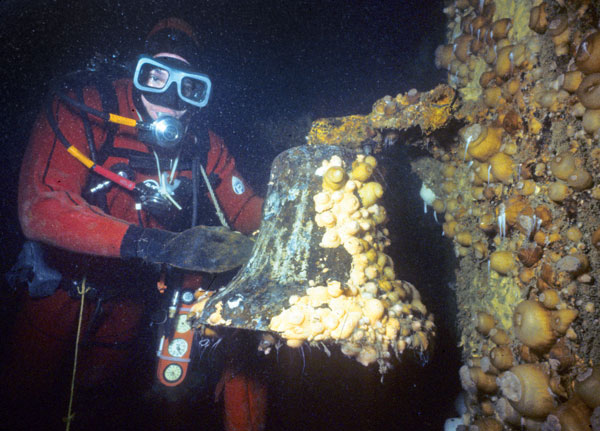Doria Tipped The Scales
By Michael Menduno

One of the world’s most iconic shipwrecks, the wreck of the SS Andrea Doria—located 110 nautical miles (200km) east of Montauk, New York and dubbed the “Mount Everest of Wreck Diving”—served as an early proving ground for would-be Northeast wreck divers to test their mettle.
Diving the Doria on air was a perilous proposition. Few could tolerate the debilitating narcosis at the 160-250ft (49-76m) depths, compounded by the cold murky North Atlantic and disorienting interior of the wreck, which lies on her starboard side and is filled with a spaghetti-tangle of electrical wiring. At those depths, there was also the risk of epileptic-like oxygen (O2) seizures. Air decompression was unreliable; divers routinely got bent. Conditions offshore are also volatile, necessitating limiting dive profiles to two hours or less.
But the dangers of diving the Doria—at least 18 people have lost their lives over the last 30 plus years—led divers to first adopt oxygen for decompression and later mixed gas technology to improve their safety and performance. The catalyst: technical diving pioneer Capt. Billy Deans, owner of Key West Diver, who began developing mix gas protocols after losing his best friend on a deep air dive on the Doria in 1985.
That year, Deans helped Steve Bielenda, owner of the RV Wahoo, one of the three dive boats that regularly plied the wreck, install an O2 decompression system that got divers out of the water faster and with fewer bends. Soon everyone was decompressing with oxygen.
Six years later, with Dean’s support, the Wahoo hosted the first mixed gas expedition on the Doria led by explorer Bernie Chowdhury, signaling the eventual demise of deep air diving. The expedition became a tipping point for the adoption of mixed gas diving. Before long, mix classes were booming and the Doria became newly certified tech divers’ number one dive destination. “[Mix] put divers on par with those who could tolerate the narcosis; it enabled them to make dives they couldn’t have before,” explained wreck diving pioneer and author Gary Gentile, who has made 200 dives and written two books on the 700-foot (231m) Italian luxury liner that sank on July 26, 1956 after colliding with the MV Stockholm.
Today, the interior of the Doria no longer exists. Her insides have collapsed under the weight of the wreck, which is rapidly sinking into the seabed. There’s also been a drastic reduction in the number of divers venturing to the Doria; these days it can be difficult to fill a private charter. Not surprising, rebreathers have replaced open circuit as the technology du jour, though you can still occasionally see a wreck diver sporting doubles filled with trimix.
The prospect of finding artifacts has also changed. Back in the day, divers were almost guaranteed some Doria china or other artifacts; today they’re much harder to find. That hasn’t deterred Doria veterans like explorer and photographer Steve Gatto, who has upwards of 250 dives on the wreck, and who says the deterioration is a double-edged sword. “While closing off old areas, it’s opening new ones. There will always be something to find.”
Leave a Comment







